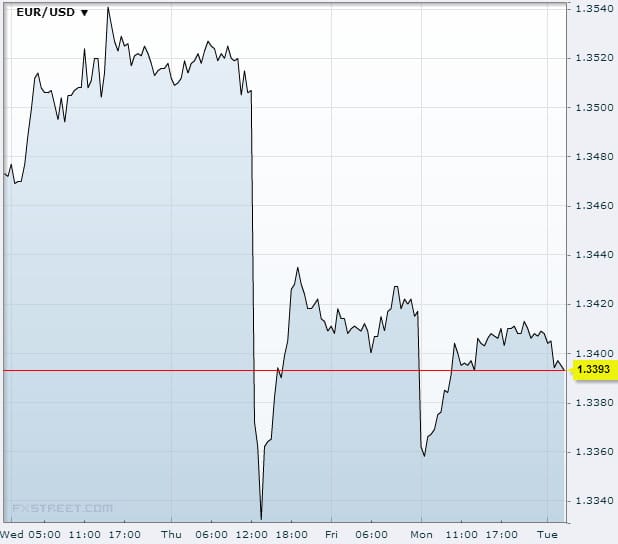The recent moderate gains made by the euro were sustained in overnight trading, with traders trimming their bearish positions on the EUR/USD pairing after last week’s heavy selloff.
In the absence of any new market-moving data regarding the single currency, much of the market seems to be locking in profits from the recent downtrend. This has prompted a moderate rally in the euro, with the price drifting up to around the $1.3410 mark from yesterday’s low of $1.3345, which was a little away from the two-month low of $1.3295 that was reached last Thursday. Despite the rally, the euro is still around 3% lower than last month’s two-year peak of $1.3833.

Source: FXstreet.com
The euro fared better against the yen, the Australian dollar, and the pound, recovering nearly all of the losses suffered on Thursday. The big dip was caused by a surprise interest rate cut to a historic low of 0.25% by the European Central Bank, which few analysts were expecting and even fewer traders, judging by the scale of the selloff. after the European Central Bank wrong footed euro bulls by cutting its main rate to a record-low 0.25 percent.
“The euro’s recovery likely reflects profit-taking on shorts as well as reaction to reports in the press last week suggesting a sizable bloc on the governing council objected to last week’s easing and would presumably lobby against further measures,” said analysts in a BNP Paribas client note.
“We think this latest bounce in the euro is setting up potentially good opportunities to enter new shorts versus the dollar and sterling, as well as versus the higher yielding commodity bloc currencies.”
Despite the euro’s recovery against some major currencies, it is widely expected that the EUR/USD will continue its downtrend, due to continued divergence in the monetary policy outlooks in Europe and the US.
The recovery in Europe has been sluggish indeed in recent times, and the ECB is under increasing pressure to use monetary stimulus measures – such as LTRO for example – to prevent the Eurozone from entering into the kind of deflationary spiral suffered by Japan in recent times. Meanwhile, encouraging economic news coming out of the US has made it look increasingly likely that the Fed will finally start tapering its bond-buying programme, after several false starts.
The big event for sterling traders this week will be the Bank of England’s inflation report, which is due out on Wednesday. The major focus for sterling this week is the Bank of England’s inflation report due on Wednesday. The central bank has to strike a difficult balance between tempering market speculation that interest rates could be set to rise while upgrading its forecasts for employment and the economy.
Read More:
What is emotionless option trading?
Tradersdna is a leading digital and social media platform for traders and investors. Tradersdna offers premiere resources for trading and investing education, digital resources for personal finance, market analysis and free trading guides. More about TradersDNA Features: What Does It Take to Become an Aggressive Trader? | Everything You Need to Know About White Label Trading Software | Advantages of Automated Forex Trading



































